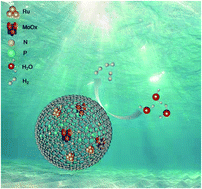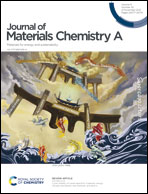Weakened lattice-strain effect in MoOx@NPC-supported ruthenium dots toward high-efficiency hydrogen generation†
Abstract
Designing a conductive amorphous buffer layer between crystals (or lowering the crystallinity of one component) to minimize lattice-strain influence between a highly crystalline substance and nearby constituents, thus ensuring good electronic structure towards multiphase synergistic electro-catalysis, is of tremendous importance for the construction of high-performance catalysts. Here, combining solvothermal and calcination strategies, oxygen vacancy-abundant amorphous MoO3 and non-crystal MoO2 were implanted into amorphous N,P-doped carbon as MoOx/NPC to hybridize sub-10 nm crystalline ruthenium dots (Ru-MoOx/NPC). Amorphous NPC bridges MoOx with Ru crystal to avoid the direct contact of MoOx and Ru, thus weakening the lattice strain influence. The electrochemical measurement results show that Ru-MoOx/NPC exhibits excellent catalytical capacity towards hydrogen evolution reaction (HER), which only needs overpotentials of 30 mV and 27 mV to deliver the current density of 10 mA cm−2 in alkaline and acid electrolytes, respectively, outperforming numerous recent-reported catalysts. Such superior HER activity can be attributed to structural advantages of abundant oxygen deficiency, small-sized Ru dots, conductive amorphous NPC, and weakened lattice-strain for the maximum protection of key components. This study not only presents a well-defined nanostructure with high HER activity but also offers insight into the weakening of lattice-strain effects to support the catalytical property.

- This article is part of the themed collection: Journal of Materials Chemistry A HOT Papers


 Please wait while we load your content...
Please wait while we load your content...